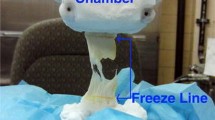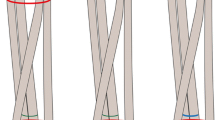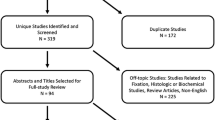Abstract
The purpose of this study was to determine whether the pull-through force of soft-tissue allografts increases over time after being hydrated with saline-soaked sponges. Eighteen aseptic soft-tissue, fresh-frozen anterior tibialis allograft specimens were thawed and sized using standard sizing guides. After sizing, initial pull-through force was measured using an Instron Model 5865 machine. Grafts were randomized to soak in saline sponges for 20, 40, or 60 min. After soaking, pull-through force was again assessed. Pre- and post-soaking pull-through forces were compared using a paired t test. The effect of time on pull-through force was evaluated using an ANOVA and Tukey post hoc test. Two allografts had initial pull-through forces outside the inclusion criteria and were excluded. The average pull-through force for the remaining 16 allografts pre-soaking was 43.0 N and post-soaking was 81.7 N, for an increase of 90 % (P < 0.001). Longer hydration time in the saline soaked sponges was not correlated with higher pull-through force (P = 0.724). Pull-through force post-hydration was not related to the allograft diameter (P = 0.641). Post-hydration, 33 % of grafts that had soaked for 20 min and 40 % of grafts that had soaked for 40 or 60 min required greater than 100 N pull-through force. Our data supports the hypothesis that soft-tissue allografts swell as a result of being stored in saline-soaked sponges, resulting in greater pull-through forces during graft passage. Surgeons should bear in mind that allografts swell when stored in saline-soaked gauze and should size their tunnels accordingly.

Similar content being viewed by others
References
Blyth MJG, Gosal HS, Peake WM, Bartlett RJ (2003) Anterior cruciate ligament reconstruction in patients over the age of 50 years: 2- to 8-year follow-up. Knee Surg Sports Traumatol Arthrosc 11:204–211
Busam ML, Rue JP, Bach BR Jr (2007) Fresh-frozen allograft anterior cruciate ligament reconstruction. Clin Sports Med 26(4):607–623
Cohen SB, Sekiya JK (2007) Allograft safety in anterior cruciate ligament reconstruction. Clin Sports Med 26:597–605
Dahm DL, Wulf CA, Dajani KA, Dobbs RE, Levy BA, Stuart MA (2008) Reconstruction of the anterior cruciate ligament in patients over 50 years. J Bone Joint Surg Br 90:1446–1450
Ghodadra N, Mall NA, Karas V, Grumet RC, Kirk S, McNickle AG, Garrido CP, Cole BJ, Bach BR Jr (2012) Articular and meniscal pathology associated with primary anterior cruciate ligament reconstruction. J Knee Surg, 2012 Nov 6 [Epub ahead of print]
Inacio MC, Paxton EW, Maletis GB, Csintalan RP, Granan LP, Fithian DC, Funahashi TT (2012) Patient and surgeon characteristics associated with primary anterior Cruciate ligament reconstruction graft selection. Am J Sports Med 40(2):339–345
Kuhn MA, Ross G (2007) Allografts in the treatment of anterior cruciate ligament injuries. Sports Med Arthrosc 15(3):133–138
Rogell MR, Parks BG, O’Donnell JB (2008) Soaking versus moist storage of autologous patellar tendon before implantation for ACL reconstruction: a cadaver study. Orthopedics 31(12): 1194. http://www.healio.com/orthopedics/knee/journals/ORTHO/%7BFFBAB218-4A9B-4B8F-906B-E99A307A027E%7D/Soaking-Versus-Moist-Storage-of-Autologous-Patellar-Tendon-Before-Implantation-for-ACL-Reconstruction-A-Cadaver-Study Accessed 5 March 2013
Siebold R, Dehler C, Ellert T (2008) Prospective randomized comparison of double-bundle versus single-bundle anterior cruciate ligament reconstruction. Arthroscopy 24:137–145
Stein DA, Brown H, Bartolozzi AR (2006) Age and ACL reconstruction revisited. Orthopedics 29:533–536
Suarez LS, Richmond JC (2007) Overview of procurement, processing, and sterilization of soft tissue allografts for sports medicine. Sports Med Arthrosc 15:106–113
Tejwani SG, Shen W, Fu FH (2007) Soft tissue allograft and double-bundle reconstruction. Clin Sports Med 26(4):639–660
Trojani C, Sané JC, Coste JS, Boileau P (2009) Four-strand hamstring tendon autograft for ACL reconstruction in patients aged 50 years or older. Orthop Traumatol Surg Res 95:22–27
Yasuda K, Tanabe Y, Kondo E, Kitumara N, Tohyama H (2010) Anatomic double bundle anterior cruciate ligament reconstruction. Arthroscopy 26(9 Suppl 1):S21–S34
Acknowledgments
The allograft specimens for this study were donated by RTI Biologics, Inc, Alachua, FL. The testing was carried out in their laboratory. Joanne Clarke assisted in editing and revision of this manuscript.
Author information
Authors and Affiliations
Corresponding author
Rights and permissions
About this article
Cite this article
Altbuch, T., Conrad, B.P., Shields, E. et al. Allograft swelling after preparation during ACL reconstruction: do we need to upsize tunnels?. Cell Tissue Bank 14, 673–677 (2013). https://doi.org/10.1007/s10561-013-9370-4
Received:
Accepted:
Published:
Issue Date:
DOI: https://doi.org/10.1007/s10561-013-9370-4




